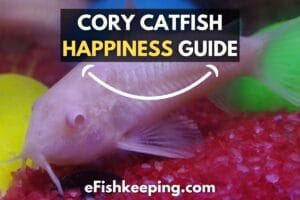Tiger barbs are a beautiful addition to any tank, brightening it up and adding more variety. While they might be beautiful, Tiger Barbs are somewhat difficult to keep alive, thriving in very specific conditions and losing their health quickly.
If you keep putting them in your tank and wind up with dead tiger barbs, it could have something to do with the water temperature or the PH. Since tiger barbs are sensitive to changes, they often don’t respond to changes, unable to survive even the slightest unbalance in their tank conditions.
Keeping tiger barbs in your tank is not impossible, though it can be tough if you’re barely starting out. Below, I’ll dive into some ways that you can keep your Barbs safe and keep them alive.
A Few Facts About Tiger Barbs
Tiger Barbs have become a popular tank addition due to their appearance and their ability to survive more than 7 years. Apart from that, some quick facts about Tiger Barbs include:
- Level of Care – Easy
- Tank Behavior – Playful but Aggressive
- Color – Come in a ton of varieties
- Size – 2 to 3 inches
- Diet – Omnivore
- Lifespan – Up to 7 years
Are Tiger Barbs Hard to Keep Alive?
Even if you’re a pro fish keeper, you’re likely going to want to stick with fish that are easy to keep up with. Some fish come with tedious maintenance, making them difficult to keep.
When it comes to Tiger Barbs, they are not hard to keep alive.
You won’t have to worry about their interactions with other fish, and you can add them along with almost any tank.
On top of that, you’ll notice that they won’t grow too big. And once they’ve adapted to your tank, they tend to be very outgoing and playful with their tank mates.
Why Are My Tiger Barbs Dying?

Tiger Barbs, like all other fish, are super sensitive to tank conditions. They like to have water that is a certain temperature and pH, as well as tank mates that favor their conditions.
If you’ve tried to add Tiger Barbs to your tank a few times and been unsuccessful, here is what you should check.
#1. Your Tank
A tank is so much more than just a container filled with water. Tanks have to be set up correctly and account for things like light, temperature, and population.
It also helps to know what kinds of conditions tiger barbs prefer, like open space to swim, soft, slightly acidic water, and access to both live and artificial plants.
#2. Overfeeding
Fish are tiny and don’t really eat as much as we expect them to. For a lot of Tiger Barb owners, especially new ones, overfeeding can be an issue.
Fish may appear hungry as they flock toward food as soon as you put it in, but that’s just instinct.
Whatever your fish eat has to digest and come out somehow, which could lead your tank to become dangerously acidic. This will kill your fish quickly, so give them only the recommended amount of food and nothing more.
#3. Rapid Changes
Tiger Barbs need a set of very specific conditions to survive. When those conditions change, especially rapidly, your fish could be in danger.
Your fish can adapt to new conditions, though they would need to do so gradually, with any kind of quick changes causing them to eventually die.
#4. Disease or Parasite
Fish are living things and are therefore at risk of exposure to illnesses and diseases. Certain stresses can mean that your tank is more susceptible to infection, passing on from the water to the fish.
If your Tiger Barbs died and you controlled for tank conditions, you could have an issue with a virus or disease.
If you notice a sudden change in swimming and eating habits, you may want to separate your fish from one another, preventing a widespread infection throughout your tank community.
#5. Loss of Beneficial Bacteria
Bacteria get a bad rep, but there are both good guys and bad guys.
Sometimes, with the loss of good bacteria, bad things can grow and cause a disruption of your tank. Before adding anything to your tank, you should first run it through a cycle.
From there, you should have a tank that’s functioning well and providing your fish and plants with all they need to live happy and healthy.
Tip – During a water change, be sure to add something to dechlorinate. Chlorine may be good for some waters, but it is a highly potent chemical that could kill good bacteria and fish.
Why Are My Tiger Barbs at the Bottom of the Tank?
You can think of Tiger Barbs as a social fish. They tend to get along well with other fish, though they may need some time to adjust to their environment if new.
If you’ve noticed that your tiger barbs are hanging out at the bottom of your tank, they could just need some getting used to.
Very young fish, very small fish, or most new fish tend to be a bit more shy when moving from one place to another. They may hide out at the bottom, in corners, or even behind structures you have in your tank.
How Do You Keep Tiger Barbs Alive?
Whether you already have Tiger Barbs or are just thinking about adding some to your tank, you should know what it takes to keep them alive.
Below, I’ll introduce some key things to consider when adding them to your tank, helping you keep them thriving.
#1. Tiger Barb Water
There are a ton of great things about the Tiger Barb, one of which is that they can easily adjust to a wide range of waters.
To make sure that they are in the best possible conditions, go with soft, slightly acidic water in their tank.
#2. Tiger Barb Habitat
When adding Tiger Barbs to your tank, always keep in mind the amount of space they have to swim around.
Tiger Barbs love to have a lot of space to swim and play, and they don’t do well in overcrowded tanks.
Apart from having plenty of space, Tiger Barbs love to have places to hide and things to swim around.
Be sure to add a few artificial and live plants and provide a good amount of lighting so that they can tell the difference between day and night.
#3. Tiger Barb Diet
There is not really anything that a Tiger Barb won’t eat, including other fish friends. To keep them at their healthiest, it’s recommended to give them a variety of foods, making sure that you keep things in small sizes.
The variety of food to consider is flake food, frozen foods, and vegetables.
Flake food should be the main source of nutrition in their diet, though you can mix it up and give them chopped cooked veggies one day and frozen brine shrimp another.
Read Also: Can You Let Your Fish Eat Brine Shrimp Everyday?
While it’s simple to find things to feed your Tiger Barb, the one thing to be cautious about is the amount of food you give them.
Feed them according to instructions on your flake food, and do not go over recommended amounts, even if you think that they are still hungry.
You will notice that they will continually pick at plants and may even test some stuff that’s stuck to the tank out of curiosity.
#4. Tiger Barb Breeding
If you’re considering breeding, then you’ll need to keep a few things in mind.
First of all, Tiger Barbs like to gobble up floating things in the tank, some of which could include eggs. When eggs are laid, they take off and float around the tank, susceptible to lots of dangers.
So, if you’re considering breeding, set up a different tank and designate it for eggs only. You can remove the Tiger Barbs after that, giving the new generations some time to grow before you add them in with all the others.
#5. Tiger Barb Attitude
When adding Tiger Barbs to a new tank, be sure to give them some time to adapt. Provide them with places to hide and monitor to make sure that they are getting food during each feeding.
They can be intimidated in new places, unsure of where to swim and if they are safe.
Once they feel secure, you’ll notice a big change, including them hanging out at the top of the tank and swimming around with other fish while they explore the tank. They like interaction, especially with tank mates like:
- Rosy Barbs
- Cory Catfish
- Clown Loach
- Neon Tetra
- Pictus Catfish
Conclusion
Tiger Barbs are an easy fish to keep that add beautiful colors to any tank. Though they are simple, there are still a few things to consider before adding them to your tank, doing what you can to keep them alive.
If your Tiger Barbs keep dying, it could be a number of things, so keep a lookout for common dangers.
Recommend Reading:
Hi! I’m Praveen Ghoshal, the founder of eFishkeeping.com. Inspired by my Dad, I got interested in fishkeeping when I was a kid. Since then, I have been involved with this hobby. Currently, I have 3 fish tanks at our home, and I enjoy this hobby with my full family. Read more about me here.




![Do Neon Tetras Die Easily? [Here’s The Truth!] do-neon-tetras-die-easily](https://efishkeeping.com/wp-content/uploads/2023/03/do-neon-tetras-die-easily-300x200.jpg)



